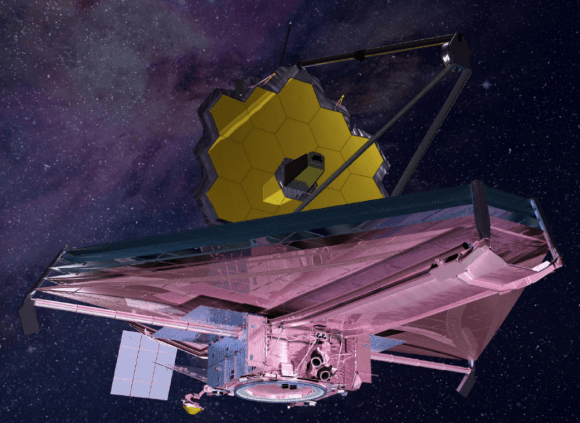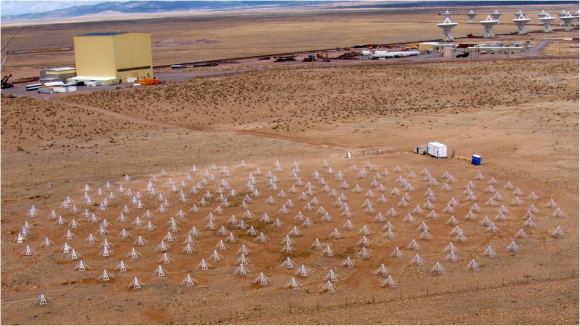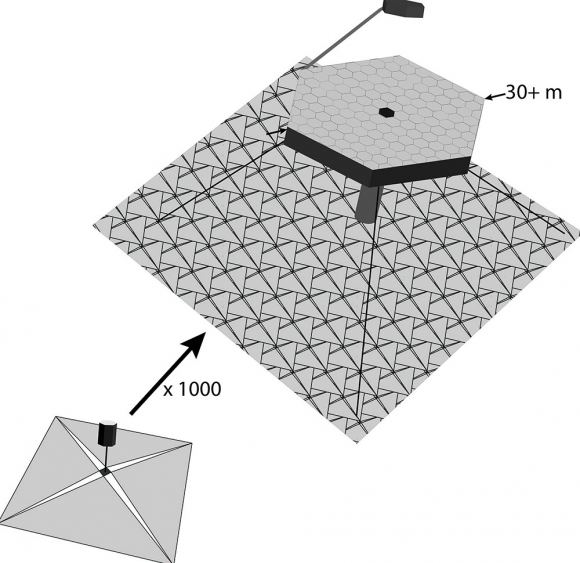In the coming decade, a number of next-generation instruments will take to space and begin observing the Universe. These will include the James Webb Space Telescope (JWST), which is likely to be followed by concepts like the Large Ultraviolet/Optical/Infrared Surveyor (LUVOIR), the Origins Space Telescope (OST), the Habitable Exoplanet Imager (HabEx) and the Lynx X-ray Surveyor.
These missions will look farther into the cosmos than ever before and help astronomers address questions like how the Universe evolved and if there is life in other star systems. Unfortunately, all these missions have two things in common: in addition to being very large and complex, they are also very expensive. Hence why some scientists are proposing that we rely on more cost-effective ideas like swarm telescopes.
Two such scientists are Jayce Dowell and Gregory B. Taylor, a research assistant professor and professor (respectively) with the Department of Physics and Astronomy at the University of New Mexico. Together, the pair outlined their idea in a study titled “The Swarm Telescope Concept“, which recently appeared online and was accepted for publication by the Journal of Astronomical Instrumentation.

As they state in their study, traditional astronomy has focused on the construction, maintenance and operation of single telescopes. The one exception to this is radio astronomy, where facilities have been spread over an extensive geographic area in order to obtain high angular resolution. Examples of this include the Very Long Baseline Array (VLBA), and the proposed Square Kilometer Array (SKA).
In addition, there’s also the problem of how telescopes are becoming increasingly reliant on computing and digital signal processing. As they explain in their study, telescopes commonly carry out multiple simultaneous observation campaigns, which increases the operational complexity of the facility due to conflicting configuration requirements and scheduling considerations.
A possible solution, according to Dowell and Taylor, is to rethink telescopes. Instead of a single instrument, the telescope would consist of a distributed array where many autonomous elements come together through a data transport system to function as a single facility. This approach, they claim, would be especially useful when it comes to the Next Generation Very Large Array (NGVLA) – a future interferometer that will build on the legacy of the Karl G. ansky Very Large Array and Atacama Large Millimeter/submillimeter Array (ALMA). As they state in their study:
“At the core of the swarm telescope is a shift away from thinking about an observatory as a monolithic entity. Rather, an observatory is viewed as many independent parts that work together to accomplish scientific observations. This shift requires moving part of the decision making about the facility away from the human schedulers and operators and transitioning it to “software defined operators” that run on each part of the facility. These software agents then communicate with each other and build dynamic arrays to accomplish the goals of multiple observers, while also adjusting for varying observing conditions and array element states across the facility.”
This idea for a distributed telescope is inspired by the concept of swarm intelligence, where large swarms of robots are programmed to interact with each other and their environment to perform complex tasks. As they explain, the facility comes down to three major components: autonomous element control, a method of inter-element communication, and data transport management.
Of these components, the most critical is the autonomous element control which governs the actions of each element of the facility. While similar to traditional monitoring and control systems used to control individual robotic telescopes, this system would be different in that it would be responsible for far more. Overall, the element control would be responsible for ensuring the safety of the telescope and maximizing the utilization of the element.
“The first, safety of the element, requires multiple monitoring points and preventative actions in order to identify and prevent problems,” they explain. “The second direction requires methods of relating the goals of an observation to the performance of an element in order to maximize the quantity and quality of the observations, and automated methods of recovering from problems when they occur.”
The second component, inter-element communication, is what allows the individual elements to come together to form the interferometer. This can take the form of a leaderless system (where there is no single point of control), or an organizer system, where all of the communication between the elements and with the observation queue is done through a single point of control (i.e. the organizer).

Lastly, their is the issue of data transport management, which can take one of two forms based on existing telescopes. These include fully 0ff-line systems, where correlation is done post-observation – used by the Very Long Baseline Array (VLBA) – to fully-connected systems, where correlation is done in real-time (as with the VLA). For the sake of their array, the team emphasized how connectivity and correlation are a must.
After considering all these components and how they are used by existing arrays, Dowell and Taylor conclude that the swarm concept is a natural extension of the advances being made in robotic and thinking telescopes, as well as interferometry. The advantages of this are spelled out in their conclusions:
“It allows for more efficient operations of facilities by moving much of the daily operational work done by humans to autonomous control systems. This, in turn, frees up personnel to focus on the scientific output of the telescope. The swarm concept can also combine the unused resources of the different elements together to form an ad hoc array.”
In addition, swarm telescopes will offer new opportunities and funding since they will consist of small elements that can be owned and operated by different entities. In this way, different organizations would be able to conduct science with their own elements while also being able to benefit from large-scale interferometric observations.

Credit: D. Savransky
This concept is similar to the Modular Active Self-Assembling Space Telescope Swarms, which calls for a swarm of robots that would assemble in space to form a 30 meter (~100 ft) telescope. The concept was proposed by a team of American astronomers led by Dmitri Savransky, an assistant professor of mechanical and aerospace engineering at Cornell University.
This proposals was part of the 2020 Decadal Survey for Astrophysics and was recently selected for Phase I development as part of the 2018 NASA Innovative Advanced Concepts (NIAC) program. So while many large-scale telescopes will be entering service in the near future, the next-next-generation of telescopes could include a few arrays made up of swarms of robots directed by artificial intelligence.
Such arrays would be capable of achieving high-resolution astronomy and interferometry at lower costs, and could free up large, complex arrays for other observations.
Further Reading: arXiv


Government projects tend to be massive and provide jobs for those with academic resumes for decades.
The recent “delay” in the James Webb is massively funded with the threat that the team will walk off the job if the “grants” are not renewed and all that work will go to waste.
Welcome to Space Shuttle when what the article (and we) want is SpaceX.
Tom, I have to disagree with you.
What about the many many hundreds of people that work on the projects that are not, what you deride as those with academic resumes. It is congress that determines which NASA project goes forward, not some one with grant money.
It seems as if you do not think things out, but just spout the party line, so to speak. I would quote Judge Judy, but I will not!
Nothing new about the idea of multiple telescopes working together. I believe it has been around since the late seventies.
This was about using ground based telescopes all viewing the same object, which would act as a very large telescope.
For ground based it worked fine, but for space based the computing and technological base was not up to the ideal needed.
Problem also was, that almost, but not all, knelt at the altar of one big, huge expensive project, was the word of the science funding gods.
Back in the mid-60’s, when Lyman Spitzer was campaigning for the large space telescope that eventually became HST, there was a competing proposal to launch a constellation of 1 meter space telescopes that could go into space on existing expendable launch vehicles. We got the OAO (Orbiting Astronomical Observatory) program, which gave us four moderately sized space telescopes, the most successful of which was OAO-3, the Copernicus mission. But we learned that modestly sized missions are much easier to cancel than large ones, and this led us to the Great Observatories (Compton, Hubble, Chandra, and Spitzer) which were all so expensive and employed so many people that they could not be easily canceled. Any astronomer who’s been in the space-based astronomy biz for a while views ideas for small space telescopes askance, for good reason. After putting years into design and proposal, you get funded, only to see your funding cut and cut and cut again while your grad students and postdocs starve.
These seem like a nice |Telescope for astronomy. What kind of telescopes do you recommend? Thanks
Telescope .
I my opinion, in my price range it would be the Celestron Powerseeker 114 EQ Telescope. Lots of features also.